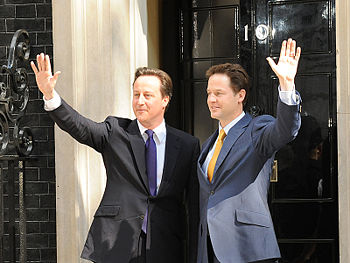Coalition government: Difference between revisions
imported>John Stephenson (linking, image and expansion) |
imported>John Stephenson (trying to explain why Japanese coalitions are common) |
||
| Line 7: | Line 7: | ||
A coalition need not include the party that received the most votes, as long as the coalition puts together a sufficient number of votes to be recognized. This is the current situation in the [[State of Israel]]. | A coalition need not include the party that received the most votes, as long as the coalition puts together a sufficient number of votes to be recognized. This is the current situation in the [[State of Israel]]. | ||
Where two parties dominate the political system, such as in the [[United States of America]] or, until 2010, the [[United Kingdom]], coalitions are rarely formed because [[election]]s typically result in a government with a majority of seats in the chamber and an opposition party with enough representation to form an effective counterweight to it. An exception is Japan, where [[ | Where two parties dominate the political system, such as in the [[United States of America]] or, until 2010, the [[United Kingdom]], coalitions are rarely formed because [[election]]s typically result in a government with a majority of seats in the chamber and an opposition party with enough representation to form an effective counterweight to it. An exception is Japan, where the historical concentration of power in a relatively small proportion of the population has led in part to a lack of major policy differences between mainstream parties or [[factionalism|factions]]; combined with the differing fortunes of parties in both [[National Diet of Japan|houses of parliament]], this has often resulted in a drive to form coalitions even when the winning party has a firm majority. For example, the [[Democratic Party of Japan]] (DPJ) formed a coalition government with the [[People's New Party]] and the [[Social Democratic Party (Japan)|Social Democratic Party]] in 2009, partly because the DPJ lacked a firm majority in the [[House of Councillors|upper house]]; however, the alliance with the SDP lasted less than a year. | ||
Revision as of 01:09, 5 June 2010

The 2010 United Kingdom general election ultimately resulted in a coalition government led by David Cameron (left) and Nick Clegg; this picture was taken shortly after they took office as Prime Minister and Deputy in May 2010. Coalitions are rare in British politics but common elsewhere.
In a multi-party democracy, a coalition government is one in which two or more political parties agree to share power. Coalitions may be formed in times of national crisis or political turmoil, though they are the norm in most European countries and are common in Japan even when one party has a working majority.
Coalition governments are most characteristic of parliamentary governments (e.g., Westminster system). Typically, the head of state will be outside the government and will approve the ruling coalition, to be led by the head of government.
A coalition need not include the party that received the most votes, as long as the coalition puts together a sufficient number of votes to be recognized. This is the current situation in the State of Israel.
Where two parties dominate the political system, such as in the United States of America or, until 2010, the United Kingdom, coalitions are rarely formed because elections typically result in a government with a majority of seats in the chamber and an opposition party with enough representation to form an effective counterweight to it. An exception is Japan, where the historical concentration of power in a relatively small proportion of the population has led in part to a lack of major policy differences between mainstream parties or factions; combined with the differing fortunes of parties in both houses of parliament, this has often resulted in a drive to form coalitions even when the winning party has a firm majority. For example, the Democratic Party of Japan (DPJ) formed a coalition government with the People's New Party and the Social Democratic Party in 2009, partly because the DPJ lacked a firm majority in the upper house; however, the alliance with the SDP lasted less than a year.